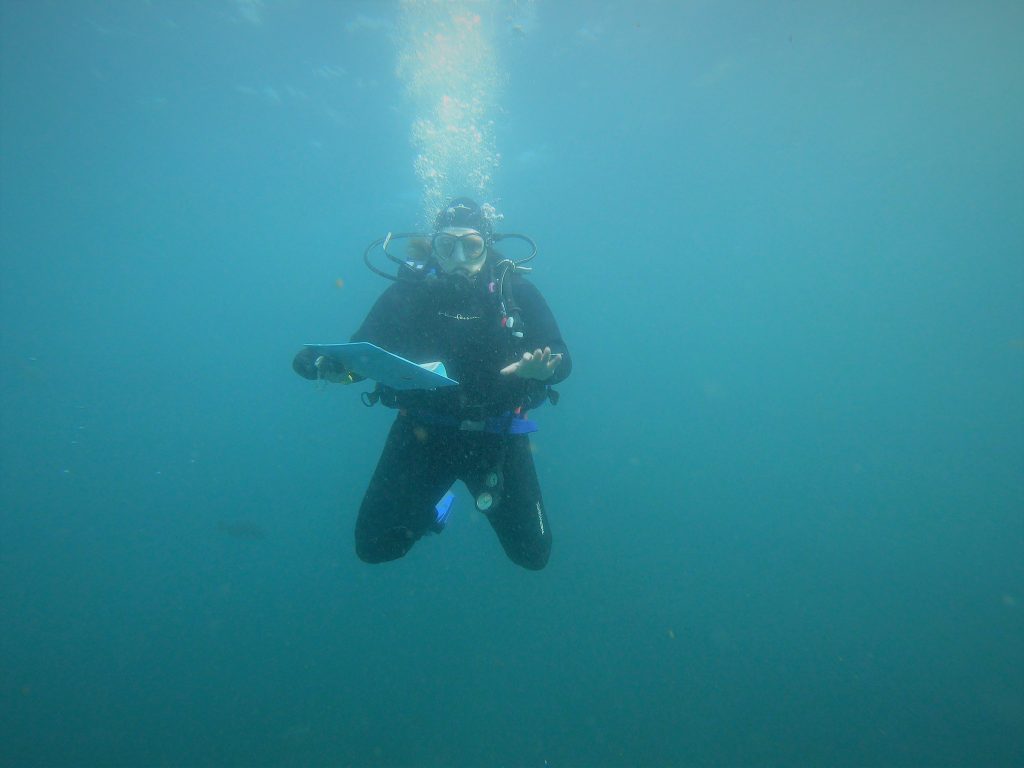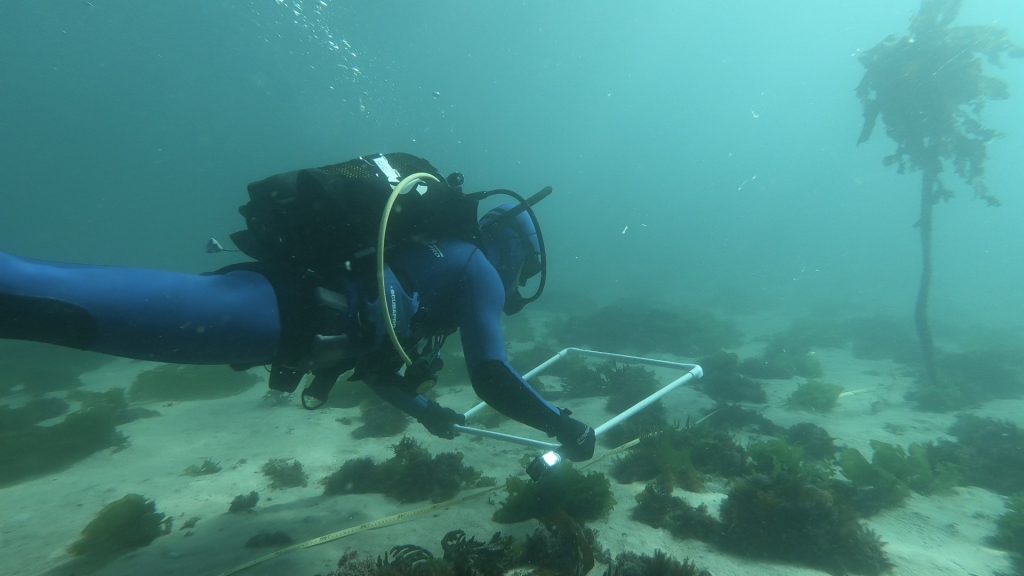As a marine field biologist or dive professional you may be involved in dive expeditions and tasks which will involve working in very sensitive ecosystems and operating scientific equipment or collecting data in a controlled manor to complete your dive objectives. You will often need to be able to cruise very close to the reef to observe or photograph the smaller critters and details on the reef or sand getting up close and personal with the environment without touching and disturbing it. This takes a diver who is completely comfortable and in control of their movement and positioning in the water, and for this one must have mastered the art of buoyancy. Having this skill will result in becoming a much more competent researcher and benefit your data collections quality and quantity during your field work.

Good buoyancy is achieved by becoming neutrally buoyant and controlling your movement in the water. This is determined by two forces, the downward force gravity and the upward force or buoyant force, when these are in balance you are neutrally buoyant. Underwater we use lead weights to create the extra downward force we need to make ourselves sink in our neoprene wetsuit and dive gear, and the upward force is determined by the displacement of water and the air in our gear and lungs.
As a field marine biologist each dive can be different with different tools, equipment, conditions and dive objectives. This is something to keep in mind when we are considering our buoyancy for the environment and job at hand. Unlike the normal recreational diver who will generally use the same weight and equipment most dives, a field marine biologist may want extra weight to help keep position in a strong current or surge when completing tasks where they need to be stable in one position (i.e. fixing a mooring down, static observations or placing fixed quadrats in place). You may be diving with video equipment or weighted quadrats which will give you extra weight to consider so you may not want as much weight on your belt or want to spread the weight out around your gear. Good knowledge of your personal buoyancy, the equipment you are using and the task at hand will make the difference between a successful dive or a complete nightmare.
Ballast Weight
The ballast weight we use on a dive does not change throughout the dive, but it’s often the biggest problem. For each extra pound of lead weight we take down with us, it must be balanced with an extra pound of buoyancy. To displace a pound of water and balance the pound of lead requires an air bubble approximately one pint in volume in the BC. However, this air bubble is going to expand and contract at varying depths which means there is a constant balancing act between the two forces, especially if your dive objectives involve a lot of movement throughout the water column (e.g. vertical point count fish survey or transect line that runs up and over pinnacles) making it important not to overweight unnecessarily. Regular buoyancy checks at the surface before a dive starts is advised to make sure you’re not over or under weighted with your equipment.
Depth

Your wetsuit buoyancy changes dramatically depending on your depth. For example, at the surface wetsuits are very buoyant as they are full of air and fully expanded, however, at 66 ft down and under 3 bars of pressure those air gaps in the wetsuit are heavily compressed, making your wetsuit much thinner and displacing less water. This change in buoyancy is lost at different rates, at 33 feet 50 % of your surface buoyancy is lost, in the next 33 ft you lose 1/3 of the wetsuit buoyancy and below this only 1/6 of the wetsuit buoyancy is apparent. My point being, the biggest change in buoyancy is in the first few feet of water below the surface and has a diminishing effect thereafter, making it harder to get down initially but subsequently making it easier to sink as we descend. Instead of over-weighting at the surface its sometimes easier to swim down and force the issue for the first few feet until you can feel that sinking feeling. BUT remember this is going to have the reverse effect on the way back up to the surface, increasing your buoyancy much faster in the final stages of the dive AND your tank will be lighter at the end of a dive. This is especially important to be aware of when you are diving with research equipment or cameras and your hands are full. It is important to always be aware of your position in the water, your rate of ascent and how you are going to control your descent and ascent safely.
Breath Control
Your lungs are natural buoyancy aids and can hold approximately 10 pounds of upward lift. A real expert diver can control their movement in the water using only their lung capacity by controlling their breathing to move up and down over the reefs, allowing your hands to be free to operate equipment and take data rather than constantly adjusting your BC.

*REMEMBER this does not mean holding your breath, but controlling how much and how fast you take in and let out.
Relax
It is so important and much more pleasant and effective when you can relax and feel completely in control and at ease with your body in the water. Flailing arms and useless finning can cause you to ascend without realising it making you over compensate with your BC let alone use up your air quicker and reduce data collection and observation time. Often on a research dive you will have equipment or data slates in your hands and can’t afford to be constantly reaching for your air hose. Using slow controlled movements with your fins and tucking your arms away if you aren’t holding anything makes you more streamline and balanced in the water.

Taking on a horizontal position in the water when moving forward helps reduce drag and control direction much better, this is called trim. Remember, having a calm and relaxed disposition will help you achieve your dive objectives. As marine field biologists, we sometimes work in stressful and challenging conditions, causing increased breathing or hyperventilation, this can affect our buoyancy hugely and can quickly get out of control if panic ensues. If you need to take a minute to focus your mind and re centre yourself on the task at hand then do so, this will calm you down, get your breathing under control and ultimately help you successfully complete your task. The most important thing when doing scientific diving field work or any diving is your safety and comfort.
Put it into Practice
The best way to learn and develop these techniques is to practice and apply your dive skills and marine biology training. Often as an undergraduate student, you don’t have the opportunity to apply what you learn in your classes. This is why the Cape RADD marine SCUBA field course was designed, to allow early career scientists searching for an opportunity to further develop their field biologist skills and apply the knowledge they have studied. Cape RADD gives future scientists an opportunity to gain hands on field experience and to work alongside marine field biologists. For more information on the course options contact us as info@caperadd.com
2 Comments
5 reasons you should join our field course internship ? - Cape RADD · May 6, 2019 at 3:24 pm
[…] Joining a summer field course internship is the best way to learn new skills often in new ways. You will be interacting with different people, different teaching staff, other students on the course with various backgrounds, and the locals in the country. You can and will learn from all of these people. Field courses are much more practical based than many University courses, which many people find much more engaging and benefit from this format much quicker. Its exciting, engaging and novel. You will leave your field course with a whole new set of skills you didn’t have before as well as having developed skills you perhaps already had. […]
DAILY DIARY OF A MARINE BIOLOGY STUDENT... - Cape RADD · August 3, 2020 at 2:12 pm
[…] rescue techniques, emergency buddy breathing, regulator recovery, mask and weight belt removal, buoyancy and anything else students want to practice. It’s important that all our students feel happy and […]